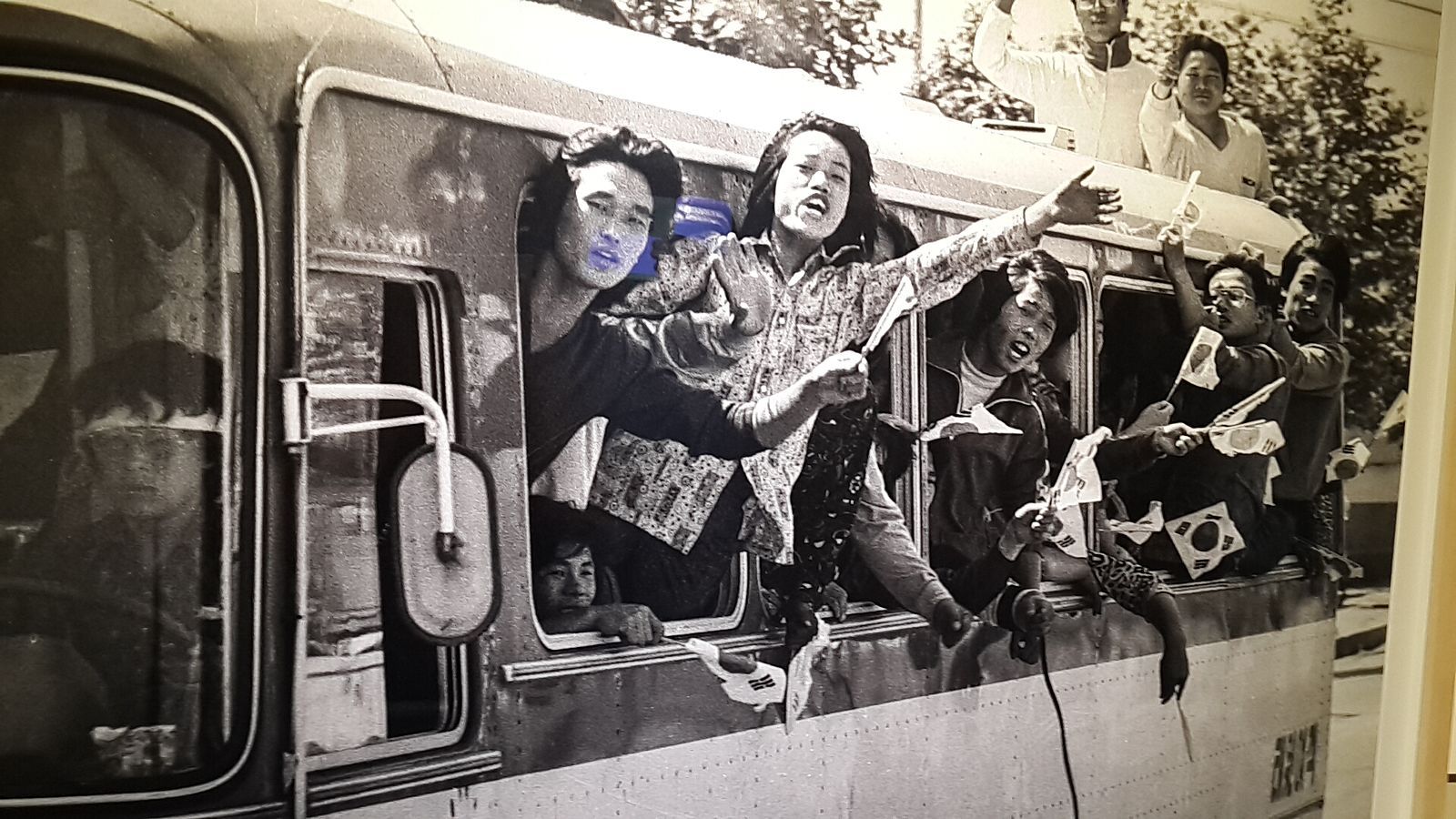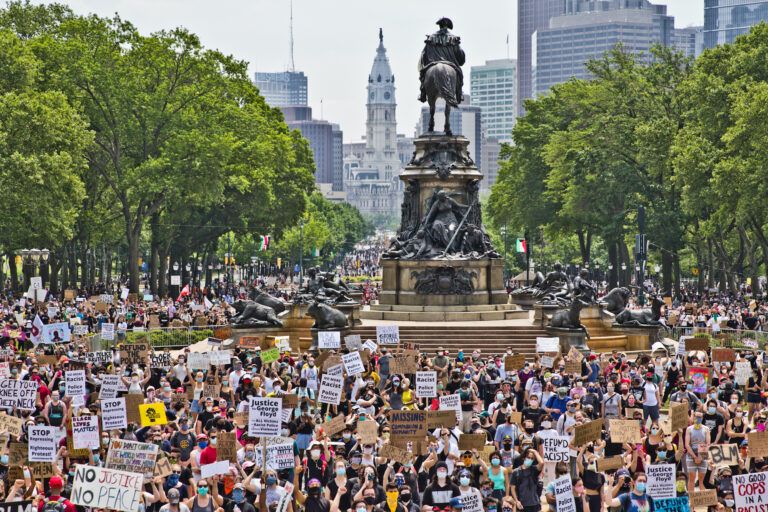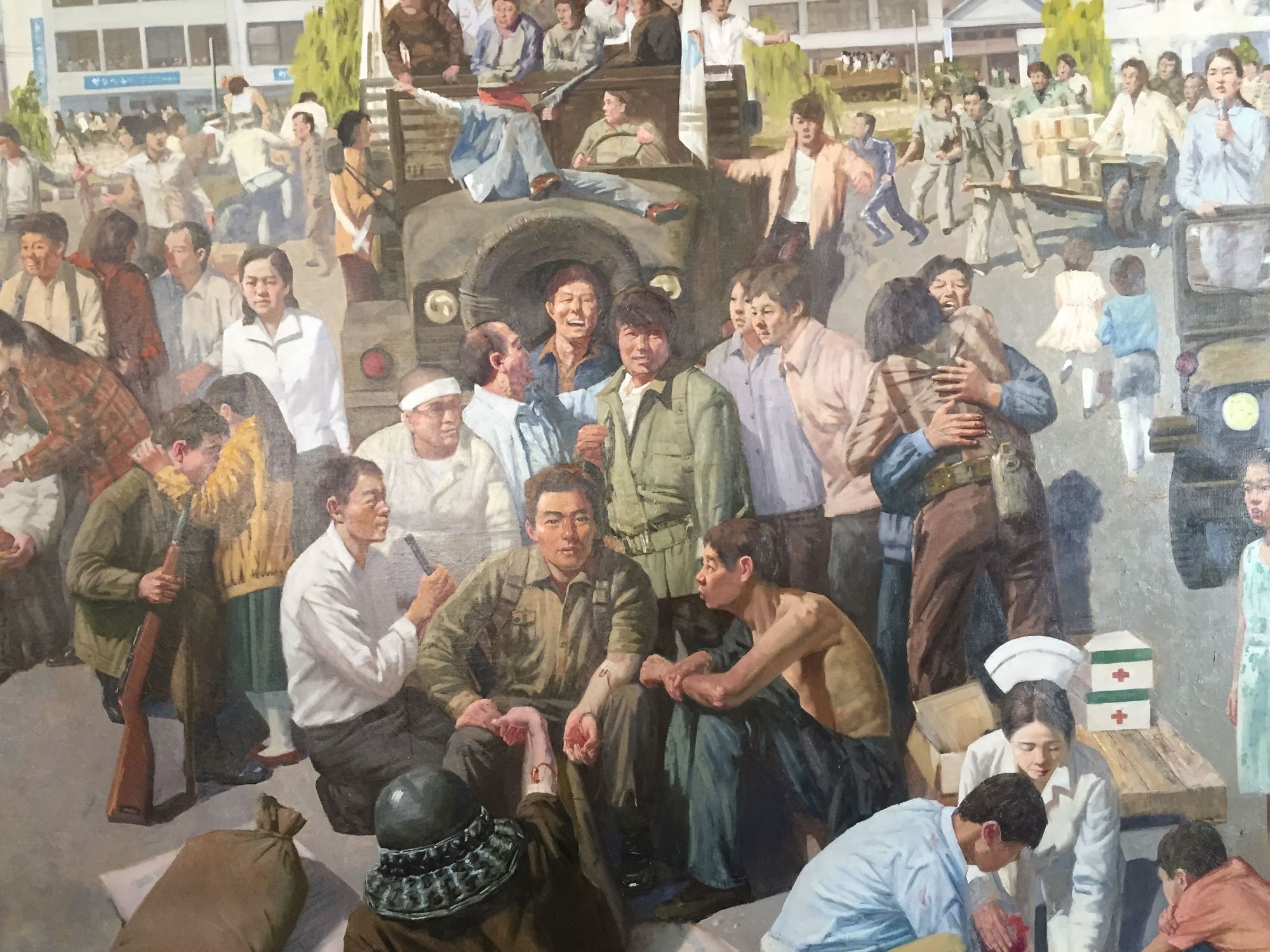Banner photo: A broadcasting car during the May 1980 Gwangju Democratization Movement. Hani KR
I have a confession. I hate that exercise that pops up in some organizing spaces where they have you create a personal narrative about what “brought” you to the movement. Sure, I can create a story about my union family, about being in high school when George W. Bush stole an election and invaded Iraq, about graduating college in 2009 during the Great Recession. But those stories wouldn’t really tell you the why of it all. I don’t know what words I can say to express the burning injustice I feel, that I have felt since I was a small girl who didn’t know what the word “injustice” meant. I tell people that, before I was anything else, I was anti-imperialist. I don’t know how to explain that I am driven by generations of intergenerational rage and trauma, the feeling we Koreans call Han. Can words really explain that I am a child of U.S. imperialism and that I fight every day to dismantle that system because I feel the contradictions of this identity so strongly in my bones? Nothing brought me to the movement. I carry it with me in my history and blood. The closest I can come is to tell the story of Gwangju.

Gwangju is a city in the South Jeolla province, known as the country’s “rice basket” as it is primarily farmland. My mom’s side of the family is from Hampyeong, the rural county outside the city of Gwangju. She and her siblings grew up impoverished in the aftermath of war-torn Korea. My uncle was the only son of six children and as such, the only one allowed to go to high school in the big city. Like many immigrants, my mom didn’t talk much about her life in Korea when I was young. My mom would tell me stories about her brother if I complained about homework. My uncle would share his textbooks with other kids who couldn’t afford school supplies, she said. He would organize study groups for the kids who couldn’t go to school.
My dad, a white man from Philadelphia, who served in the U.S. Army stationed outside of Seoul in the early 1980s, told different stories. I can’t remember the first time he told me about Gwangju. Did my dad use the word “massacre?” He told me my uncle was there. My uncle was there, somehow, and after, he was in prison. For a long time, my family didn’t know where he was held or when, if ever, he’d be released. When he did get out, he started small businesses and hired fellow comrades who were unemployed or blacklisted. He would give them the company, then move on to the next. I consider this solidarity deeply, all the time.
The city came together and drove out the police, who retreated to the countryside.
I tell my American friends that Korea is nothing like the hi-tech, K-pop wonderland they think it is. Korea hasn’t been able to determine its own destiny in over a century. In 1910, we were subjugated to brutal genocide as a colony of the Empire of Japan. After WWII, Korea was divided by a random line marking what would become the DMZ. A couple US officers took less than an hour to slash this line across my country. The only consideration they took was to ensure Seoul was in the south so that imperial powers could use Korea as a pawn in their geopolitical wargames. In the decades that followed, the U.S. propped up and supported tyrannical right-wing dictators that violently suppressed any resistance.
In 1980, this came to a head in Gwangju. South Jeolla was historically a hotbed of leftism and resistance movements and, specifically, it was the center of opposition to Chun Doo Hwan, the general who violently took the presidency in a coup in 1979. And when he instituted a repressive regime of martial law to suppress democracy, it was Jeollanam province that felt it most intensely.
The college students who went out to protest on May 18, 1980 couldn’t have known the bloodshed that would follow. The students had come to the campus of Chonnam University, which had been closed as part of Chun Doo Hwan’s authoritarian martial law. The people were met by police and paratroopers who took to clubbing and bayonetting protesters. The violence escalated over the next few days, but the city came together and drove out the police, who retreated to the countryside.
For the next six days, Gwangju was transformed into the people’s city. Decisions were made at popular assemblies, where tens of thousands gathered at Province Hall to participate in democratic decision-making. Communal kitchens fed the people, and high school girls tended to the dead. Then, the military came in with tanks and flamethrowers. Hundreds were killed by the official count, but there are also eyewitness accounts of the military burning bodies in mass graves and throwing them in rivers or lakes. Thousands who survived were sent to prison and tortured. The order to use force, knowing that civilians had already been killed, came from the highest levels of the Korean government and with the full knowledge and blessing of the United States and Nobel Peace Prize winner President Jimmy Carter.

This is all on my mind as I pass the National Guardsmen standing in the hot sun holding guns in their camo fatigues. I think about Gwangju every time I go to a protest. When I see troops’ Humvees, I think about the violence that the U.S. military continues to inflict on the Korean Peninsula—and how my dad wore that uniform, too. I think about what it must have felt like for my aunts to see their baby sister marry a U.S. soldier. Apparently, my dad was warned by his superior officers to stay away from my family, because of my dissident uncle. “That family is trouble,” he was told. I wear this anecdote as a badge of honor.
Helicopters. Tear gas. Curfew. National Guard and police in riot gear patrolling are the city. This is life right now in Philadelphia and across the United States in the wake of the murders of George Floyd, Breonna Taylor, and Ahmaud Arbery. The last several weeks have seen marches, vigils, riots, and instigation by the local police, with the reinforcement of the National Guard. Earlier this month, protesters were trapped in an underpass while the police shot them with tear gas, which also rained down from a helicopter. At that moment, I did not think of Philadelphia. I thought of Gwangju. There are buildings in Gwangju where you can still see the bullet holes from military helicopters that fired on people hiding for cover.
One of the most revolutionary things we can do is take care of each other.
The people of Philadelphia have come to the Art Museum to demand justice for George Floyd and the whole racist police system. People are giving out water and snacks, offering hand sanitizer and suntan lotion. Supply tents are filled with donated masks, ear plugs, and food. As we march, street medics are positioned on every corner, making sure everyone is okay under the blistering June heat that is our new normal under the climate crisis. There’s music and dancing. Parts of the uprising have felt like a block party, a celebration of our power and the liberation we fight for.
I look at the thousands of people and think of the black and white photos I’ve seen of the people gathered in Gwangju’s town square. I let myself imagine, just a little, if it felt like this. When I see photos of the Gwangju Uprising I wonder if one of the blurry faces is my uncle, a man I’ve only met a handful of times in my life. And yet, I’ve also seen the scars on his hands from the bullet wounds he suffered there. I wonder where my mom was during all of this. Had she already moved to Seoul? Was she still at the family house in Hampyeong? Maybe, just maybe, did she also march in Gwangju?
What Gwangju has taught me about being in the movement is, it’s not enough to oppose something. That’s the easy part. What’s harder and more beautiful is building something new with the people around you. Something as simple as sharing food is revolutionary. The Black Panthers started the Free Breakfast for School Children program and were so successful at serving the people, FBI Chief J. Edgar Hoover called it an act of subversion. The FBI launched intimidation tactics to disrupt the food programs.
Similarly, in response to the uprising in Philadelphia, the city suspended their free food programs that distribute meals at schools. This is especially devastating in Philly, already the poorest big city in the country, located in a state that has record unemployment due to the Covid-19 pandemic. Yet Philadelphians across the city have come together to organize mutual aid networks, establishing networks to provide fresh produce, food, medicine, and other necessities. Just as in Gwangju, the people have stepped up to take care of each other.

We see this time and again in crises, be it caused by the climate crisis or policy. When shit hits the fan, we see who the state and neoliberal institutions deign to protect. We see the wealthy hire private security or private firefighters to fight wildfires and cops standing guard in front of stores and racist monuments. But we also see communities come together, be in the aftermath of Superstorm Sandy or in the wake of Hurricane Maria in Puerto Rico.
One of the most revolutionary things we can do is take care of each other. We need to build institutions outside of the state. We must build the power and networks to take care of each other. Not only does the state not care about the most vulnerable among us, compounding oppressions means that the most vulnerable feel the impacts of disaster the hardest. Whether it’s a pandemic, economic depression, or hurricane, Care is Resilience. This is the lesson I take from Gwangju, the lesson I have seen in the streets of Philadelphia and countless other cities.
There is a direct line connecting the racist violence of the police in the United States and the imperial violence of the U.S. military across the world. To fight for abolition in the United States means to fight for demilitarization and anti-imperialism abroad. Soldiers and tanks parked on residential streets are an anomaly here, but an everyday reality for people around the world. Our movement must be in solidarity with anti-imperial fights abroad. As Asian Americans, we must stand in solidarity and call for Black liberation because our liberation is tied to theirs. As Fannie Lou Hamer said,
“Nobody’s free until everybody’s free.”
Abolishing the police and the military also means replacing those destructive forces with care and community. To know the story of Gwangju is to know what the state is capable of doing to its own people. It’s to know the history of the United States as an imperial terror and barrier to liberation for us all. It’s to know that fighting for abolition at home also means fighting anti-imperialism abroad. It is to know that taking care of each other is how we win. We have to get to work and build the networks of solidarity and care to dismantle imperialism, capitalism, and racism needed to free us all.

Comments powered by Talkyard.